One of the most popular and highly sought aquarium fish is the guppy, scientifically known as Poecilia reticulata. Guppies have been in the pet trade for over a century, after being discovered in the 1860s. They are small fish ranging from 1.5 to 2.5 inches long and usually live for three years.
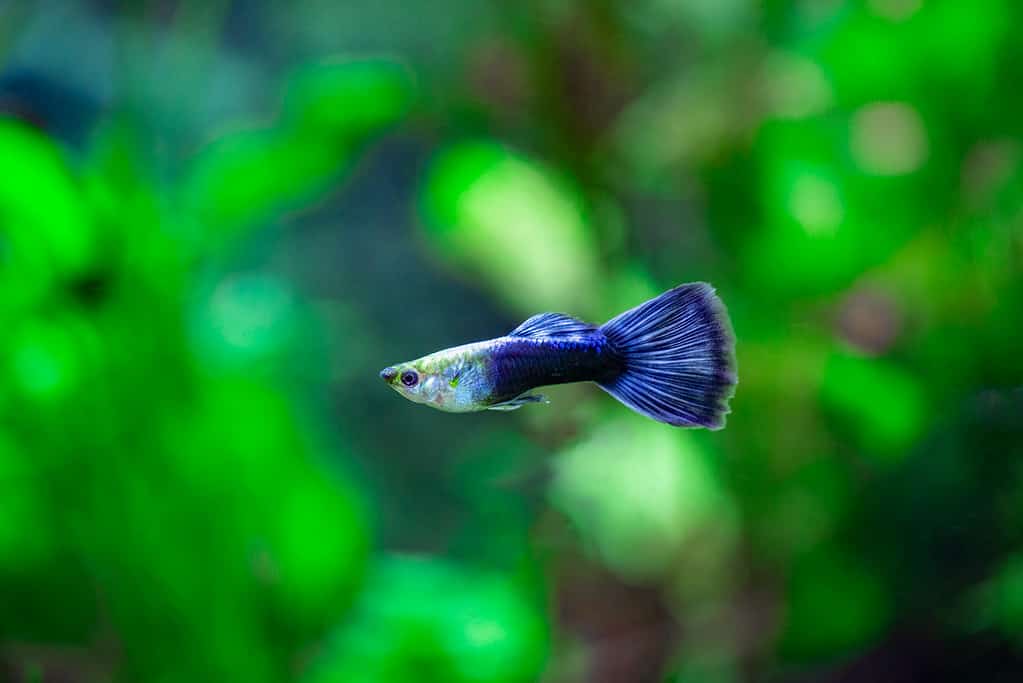
Guppies are striking and inexpensive aquarium fish that usually cost a few dollars.
©Boban_nz/Shutterstock.com
They are excellent beginner-friendly fish and one of the most popular live-bearing fish. Their popularity is mainly because of their peaceful temperaments, ease of care, and prolific breeding habits. You can find them in an extensive range of fin shapes, colors, and patterns, which has earned them the nickname of rainbow fish. Guppies are very hardy and adaptable fish that can thrive in various tank setups if their water parameters are correct.
So, if you are looking to purchase a guppy for your aquarium, this article is for you. It will guide you through the expected costs.
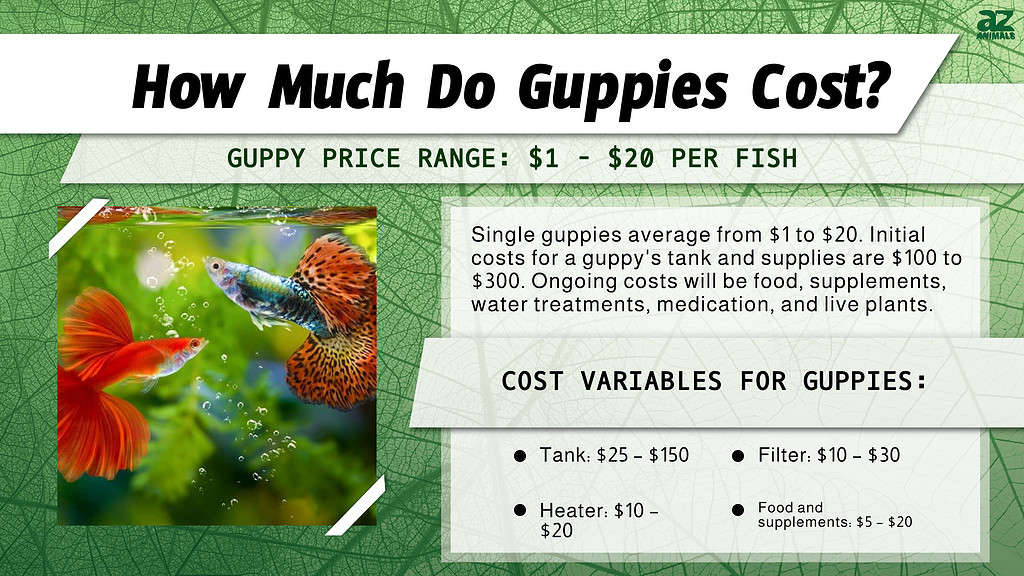
Guppy Price Range: How Much Do These Fish Cost?
Most guppies cost between $1 to $20 per fish. They are one of the most inexpensive aquarium fish you can purchase. Guppies are often sold at various pet stores, online retailers, fish breeders, and on certain buy-and-sell websites.
Despite their usual cheap price tag, some guppies are more expensive than others. The purple Moscow guppy in particular is the most expensive guppy in the world at around $40 to $100 per fish. They have a highly sought-after purple coloration that is rarely seen in guppies.
Generally, the rarer and less widely available the color form of guppies is, the more expensive the fish will be. Since guppies are social fish that need to be kept in pairs, you will need to purchase five or more guppies at a time.
Here is a breakdown of the average cost of some popular varieties of guppies:
| Variety of Guppy | Cost |
|---|---|
| Blacktail guppy: | $2 – $12 |
| Silver jaune guppy: | $2 – $15 |
| Cobra flame guppy: | $2 – $16 |
| Tuxedo rouge guppy: | $1 – $12 |
| Half green guppy: | $5 – $20 |
| Micariff yellow guppy: | $2 – $12 |
| Red bicolor guppy: | $1 – $8 |
| Female guppy: | $1 – $15 |
| Albino guppy: | $5 – $25 |
| Purple Moscow guppy: | $40 – $100 |
| Dragon tuxedo guppy: | $2 – $12 |
| Yellow cobra guppy: | $3 – $15 |
| Red guppy: | $1 – $8 |
| Blue neon guppy: | $1 – $10 |
Factors Affecting the Price of Guppies
There are certain factors that can affect the price of guppies, they include:
- The rarity: Guppies are available in different colors, patterns, and fin shapes that appeal to fish keepers. The rarer one of their color forms is, the more expensive the guppy is likely going to be. Some varieties are only available from a few select breeders, which is why they might have a hefty price tag.
- The age/size: Juvenile guppies or fry are going to be cheaper than fully grown guppies. Guppy fry doesn’t usually show their true adult colors until around four weeks old. You can expect to pay more for a fully grown and sexed guppy that is fully grown. Guppies are also very vulnerable when they are young, so they are cheaper since the seller can’t guarantee they will make it to adulthood.
- The gender: Male guppies are usually more expensive than female guppies. Although female guppies are larger, they are not nearly as colorful as males. Male guppies can be found in most varieties. Whereas most female guppies are plain silver, grey, yellow, or bronze coloration with short tail fins. Some of the more colorful female guppies can cost up to $15, but they rarely cost more than a few dollars.
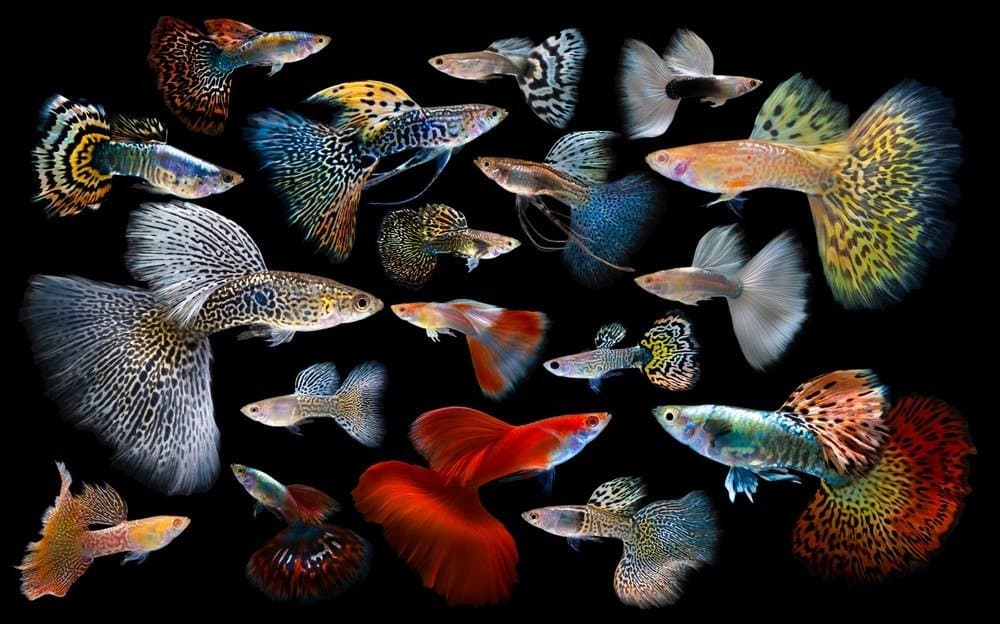
Guppies can be found in many different varieties, hence why they are sometimes called rainbow fish.
©panpilai paipa/Shutterstock.com
Guppy Purchase Considerations
One of the many reasons that guppies are such popular fish is that they are easy to care for. They are often a first choice for beginner fish keepers and are naturally resilient fish. However, they still require proper living conditions to thrive in.
Cost Of Supplies
| Supplies | Cost |
|---|---|
| Tank: | $25 – $150 |
| Filter: | $10 – $30 |
| Heater: | $10 – $20 |
| Lighting: | $8 – $20 |
| Substrate: | $3 – $15 |
| Plants or décor: | $2 – $25 |
| Food and supplements: | $5 – $20 |
| Water treatments: | $10 – $30 |
| Medications: | $6 – $38 |
| Bucket: | $1 – $5 |
| Net: | $1 – $4 |
| Siphon/gravel vacuum: | $10 – $30 |
Overall, you can expect to spend around $100 to $300 initially on a guppy’s tank and supplies. The only ongoing costs for guppies will be their food, supplements, water treatments, medication, and live plants.
Before you get guppies, these are important care and purchase considerations.
Tank Size
Guppies require a minimum tank size of five gallons, with 10 gallons being preferred. The more spacious the tank is, the more guppies you can keep inside. A group of five to six guppies can comfortably live in a 10-gallon long tank unless you keep them with tank mates. If you plan to keep guppies with other fish, their tank should ideally be over 20 gallons in size. Guppies aren’t suitable for tiny bowls or vases, since they need a spacious tank, filter, and heater to thrive.
You can expect to spend around $25 to $150 for a guppy’s tank.
Tank Setup
Guppies aren’t too fussy about their tank setup if their basic needs are being met. They absolutely need a filter and heater in their tank as they are tropical fish. A small 25-to-100-watt heater is usually recommended for guppies, and the size of the heater will depend on their tank size. The larger the tank is, the higher the heater wattage needs to be. Generally, a 25 to 50-watt heater will be sufficient for a 10-gallon fish tank.
Most filters can be used in guppy tanks, but sponge filters are preferred. Sponge filters are often the cheapest option and work quite well. You also have the option of using under gravel, hang-on-back (HOB), canister, and overhead filters. However, the filter must not produce a strong current in the water since this can be stressful for guppies. Most small filters are affordable and within the $10 to $30 price range.
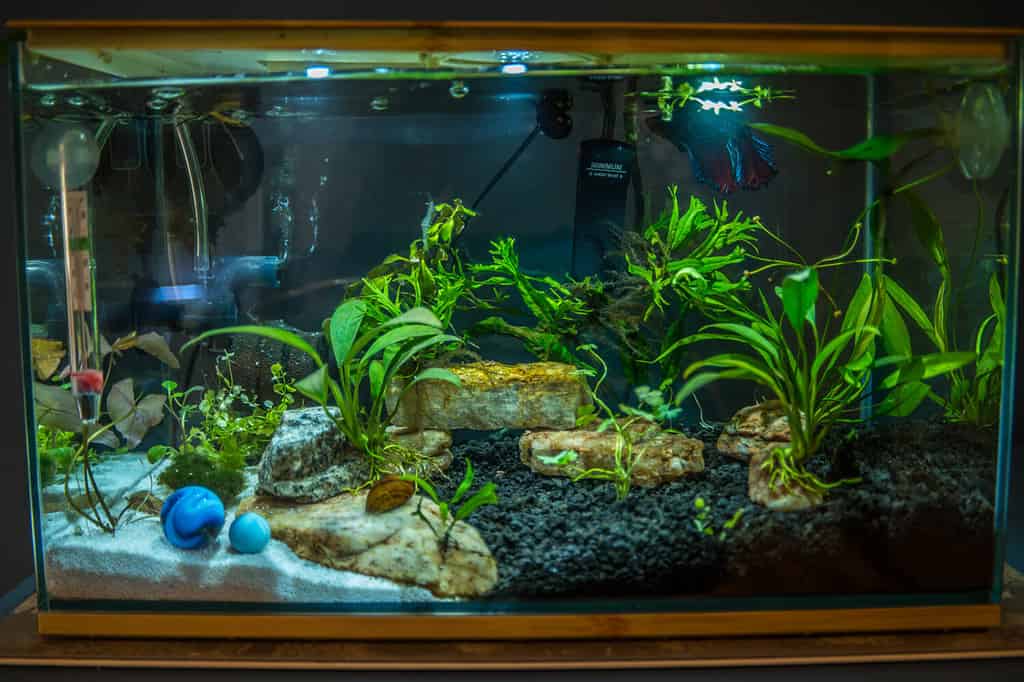
A 10-gallon aquarium is recommended for a small group of guppies.
©Sandra Burm/Shutterstock.com
You can purchase various live plants, décor, driftwood, and rocks to use as decoration in a guppy’s aquarium. This can either be cheap or expensive depending on how you want your guppy’s tank to be setup. Live plants like hornwort, water sprite, Amazon swords, and anubias are recommended for guppy tanks. They are not very expensive plants and do not require expensive fertilizers or CO2.
Any sort of substrate like gravel, sand, and quartz can be used in a guppy’s tank. A thin layer of substrate is fine unless you are using it to grow live plants. Aquarium substrate isn’t very pricey at only $3 to $15.
Water Parameters
Water quality is essential for a guppy’s health and longevity. They require specific water parameters to thrive.
- PH Range: 6.5 to 8.0
- Water hardness: 70 to 140 ppm (parts per million)
- Ammonia level: 0 ppm
- Nitrite level: 0 ppm
- Nitrate level: Below 20 ppm
Guppies need a tank that has been fully cycled weeks before they are added in. While they are hardy fish, even the slightest traces of ammonia and nitrate can be dangerous for them. You will need to regularly test their water using a liquid testing kit to determine the exact parameters in the water.
A bucket and siphon can be used to perform weekly to monthly water changes on their tank. Water changes help keep the water clean, remove poop and debris, and dilute nitrates that have built up from the nitrogen cycle.
Temperature Requirements
As tropical fish, guppies need to be kept at a temperature range of 72 to 82 degrees Fahrenheit (22 to 27 degrees Celsius). Their water temperature should be kept stable with an aquarium heater and monitored using a thermometer. Sudden temperature fluctuations and prolonged exposure to cold water can be stressful for guppies and may make them more susceptible to disease.
Diet
Guppies are omnivores that require a diet of plant and animal-based ingredients. A commercial pellet, granule, or flake food is suitable if it has been specifically formulated for guppies. These foods aren’t very pricey, so you can expect to spend between $5 to $20 depending on the food’s quality. High-quality food formulated with nutritional ingredients is preferred over ones that consist of cheap ingredients and fillers. You should ideally feed guppies once or twice a day, depending on their size and group number.
You have the option of supplementing their diet with live or freeze-dried foods like bloodworms, baby brine shrimp, and daphnia a few times a week. These foods are options but do benefit guppies and offer them additional protein. Guppies can also eat algae wafers, but not as a staple diet.
Compatibility
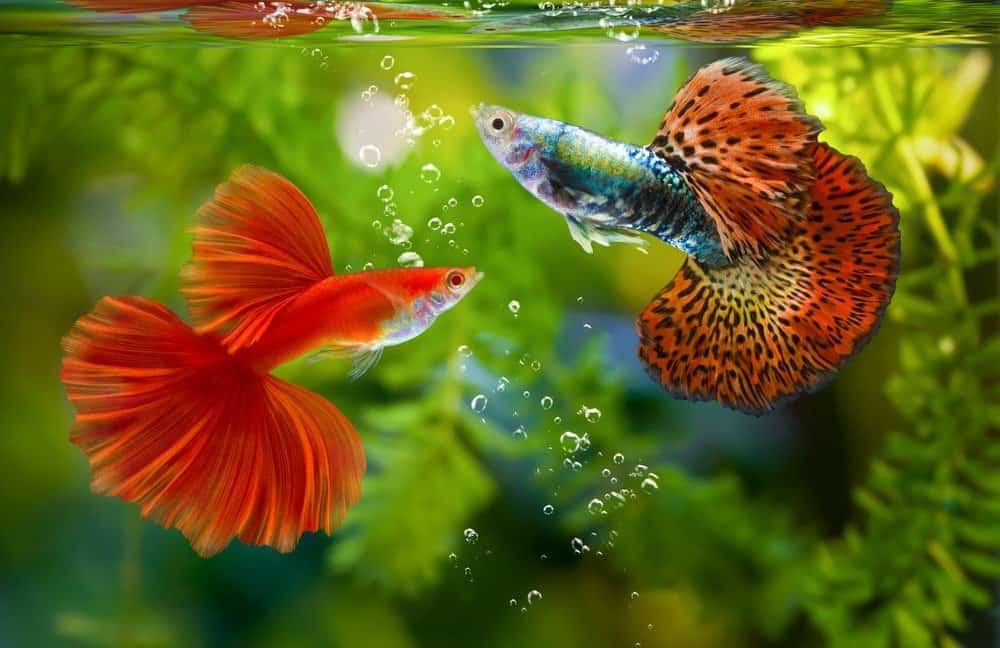
The best tank mates for guppies are other guppies as they are naturally social fish.
©panpilai paipa/Shutterstock.com
Guppies are naturally social fish that thrive in large groups of their own species. However, their peaceful temperament and small size make them excellent community fish. Guppies can be kept in the same tank as other fish and invertebrates like snails, mollies, neon tetras, and even neocaridina shrimp. You want to avoid housing them with incompatible tank mates like goldfish, Bala sharks, African cichlids, and male betta fish.
Keep in mind that the more tank mates you house with guppies, the larger the tank and filter need to be.
Resources and Platforms for Guppy Fish Care
The following resources and platforms are recommended if you plan to research more into a guppy’s care requirements.
In Conclusion
Guppies are one of the most affordable pet fish in the world. They never fail to impress fish keepers with their peaceful temperaments, endless color forms, and high compatibility in aquariums. While most guppies are cheap to purchase, the initial cost of their tank and supplies might not be. However, their ongoing costs are relatively affordable in comparison to those of many other aquarium fish.
The photo featured at the top of this post is © Norrapat Thepnarin/Shutterstock.com
Thank you for reading! Have some feedback for us? Contact the AZ Animals editorial team.





